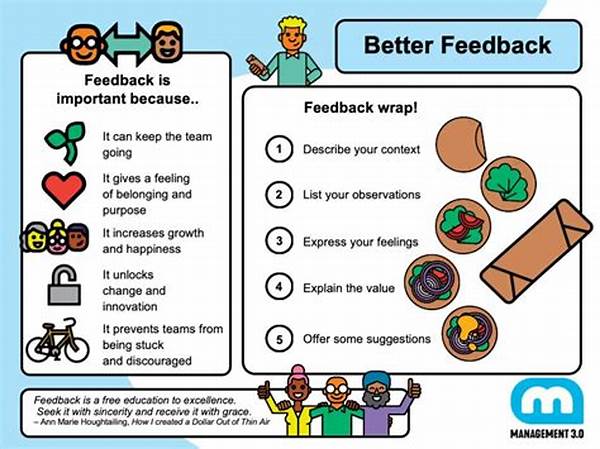In the dimly lit hall of a historic theater, dust particles danced in the shafts of sunlight streaming through cracked windows. The air hung heavy with anticipation as a diverse group of actors gathered around the director. Her voice, calm yet authoritative, broke the silence, “Today, we’ll explore constructive feedback methods in rehearsals.” The room buzzed with a combination of nerves and excitement, the actors eager to dive into the creative process. They knew that each note, comment, and critique would shape their performances, turning a group of isolated talents into a cohesive ensemble.
Read Now : Selecting Beginner-friendly Musicals
The Power of Constructive Feedback in Rehearsals
As the rehearsal unfolded, the director meticulously guided each scene. She ensured that her feedback was precise, yet enveloped in kindness. “Imagine your character’s journey,” she suggested to one actor. Her approach was a testament to the power of constructive feedback methods in rehearsals. It wasn’t merely about pointing out flaws but about unraveling a narrative delicately woven with encouragement and growth.
Through this narrative approach, actors not only received feedback but felt involved in a collective story-writing process. The director’s feedback was like a compass, steering them closer to a shared destination. As the day progressed, the actors transformed; they began to own their roles, bringing multifaceted layers to their characters. They learned to listen closely, not only to the director but also to each other. The rehearsal room became a sanctuary where creativity flourished, all because of the constructive feedback methods in rehearsals that nurtured their talents.
Five Keys to Constructive Feedback Methods in Rehearsals
1. Empathy in Understanding: Picture a scene where you step into your character’s shoes, unraveling their desires and conflicts. These insightful stories from constructive feedback methods in rehearsals ensure growth.
2. Balanced Critique: Imagine receiving notes that highlight strengths alongside areas for improvement. Constructive feedback methods in rehearsals strike this balance beautifully.
3. Specific Guidance: Envision being told, “Your character’s hesitation here wasn’t clear—try to portray it through subtle gestures.” Constructive feedback methods in rehearsals provide clarity.
4. Collaborative Effort: Think of feedback as a shared journey where each artist’s perspective shapes the final masterpiece. Constructive feedback methods in rehearsals foster team creativity.
5. Encouragement to Experiment: Recall moments when feedback encouraged you to take bold, new directions, nurturing innovation. This essence of constructive feedback methods in rehearsals opens up exploration.
Weaving Constructive Feedback into Theatrical Tapestry
The troupe gathered again, breathless and eager, awaiting the director’s insights. This time, she drew them into a story—a tale of two performers lost in a sea of critiques that stifled their creativity. She talked about how they once rehearsed, lost and overwhelmed until constructive feedback methods in rehearsals served as their lifeline. Personal experiences painted vivid images in their minds, illustrating how a shift in feedback methods brought life back to their art.
In that enlightening rehearsal, they traveled on a journey—no longer simple actors but artists crafting a shared vision. The director’s feedback, rooted in genuine investment, became the thread that stitched together their individual endeavors. Constructive feedback methods in rehearsals were no longer just a method but a cherished narrative, elevating each rehearsal to an opportunity for growth and discovery.
Techniques to Enhance Constructive Feedback Methods
1. Imagine feedback as storytelling—each note shaping a unique narrative for the performer.
2. Integrate active listening; foster a culture where feedback is a dialogue, not a monologue.
3. Use visual aids for clarity, helping actors visualize concepts.
4. Maintain a feedback journal, tracking progress and reflecting on improvements.
Read Now : “memorable Broadway Duo Moments”
5. Create an environment where questions are encouraged, promoting open discussions.
6. Encourage self-evaluation, empowering actors to identify areas for personal growth.
7. Foster peer feedback sessions, building trust and camaraderie.
8. Focus on emotional intelligence, attuning feedback to different actors’ needs.
9. Celebrate small victories, ensuring morale remains high.
10. Regularly evaluate feedback methods to ensure they’re evolving and effective.
Crafting a Rehearsal Journey through Feedback
The evening sun cast long shadows on the stage as the actors gathered for their final notes of the day. The director’s feedback was akin to a benediction—yet again emphasizing the impact of constructive feedback methods in rehearsals. In her storytelling, she reminded them of how perfect synchronicity is achieved not through critique alone but through understanding and fostering talent. A shared silence lingered, filled with gratitude for hands that did not merely mold but understood the art of gentle refinement.
Each actor reflected on the transformation they had undergone. What began as individual performances had woven into a masterpiece, ready to be shared with an audience. Constructive feedback methods in rehearsals had been their guiding star, illuminating their paths in moments of doubt. With a renewed sense of purpose, they left the theater, holding the promise of greater performances ahead—each note, each critique, a chapter in a story yet to be told.
Building Trust through Constructive Feedback
Constructive feedback methods in rehearsals are fundamentally about trust—a bond created not in demanding perfection but in nurturing growth and creativity. As the curtain fell on their rehearsal journey, there was an understanding that the path to excellence had been paved with constructive feedback—a beacon guiding them to their finest performances yet.
Elevating Performances with Constructive Feedback
In the storytelling tradition of theater, every rehearsal is an opportunity—an expedition into uncharted territories, exploring the depths of character and soul with guidance illuminating the way. Constructive feedback methods in rehearsals become an intricate dance, a balance of critique and commendation, painting a vivid tableau within the artist’s soul.
